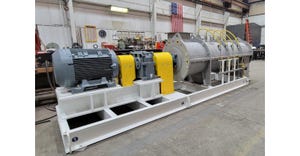July 16, 2014
A metal blender used to process zirconium powder had mechanical problems that started the reaction that caused two explosions at a West Virginia metal recycling facility that killed three employees in December 2010, according to the U.S. Chemical Safety Board’s (CSB) report released Wednesday.
The blender was not repaired and in the presence of metal dusts being broken down and reduced in size, the risks of a fire and explosion increased, said Johnnie Banks, the board’s lead investigator, in a press release issued by the CSB.
The Board issued its final report and safety recommendations on the explosion and fire at the AL Solutions facility in New Cumberland, West Virgina. It also put together a video with details of the incident that can be viewed below.
The Board’s report encouraged OSHA to create a comprehensive combustible dust standard in order to prevent incidents such as the one at the AL Solutions facility.
“Preventable combustible dust explosions continue to occur, causing worker deaths and injuries,” said chairperson Rafael Moure-Eraso. “The CSB believes it is imperative for OSHA to issue a comprehensive combustible dust standard for general industry with clear control requirements to prevent dust fires and explosions.”
The Board, which is an independent federal agency that investigates industrial chemical accidents, reported that the incident at AL Solutions occurred at about 1:20 pm on Dec. 9, 2010. Spark or heat from the blender ignited zirconium powder at the facility, according to the report. That fire then ignited metal dust particles in a blender that formed a burning metal dust cloud. That cloud then ignited other combustible dusts within the facility, causing a second explosion that killed the three employees and injured a contractor.
There are specific National Fire Protection Association practices recommended to control metal dust, but AL Solutions did not follow those guidelines and there are no federal OSHA rules to enforce similar practices, the report stated.
“Had a national standard for combustible dust been in place in 2006 – and if industry had followed the requirements – many of the severe dust incidents that followed, including AL Solutions, may have been prevented,” said Moure-Eraso. “The time is now for OSHA to take action to prevent these tragic accidents.”
The CSB’s report found that the AL Solutions facility had fatal fires and explosions in 1995 and 2006, and seven fires that required the fire department to respond from 1993 to 2010.
OSHA fined the company more than $154,000 for the accident. The company also reached a settlement earlier this year to pay nearly $200,000 in civil penalties to the U.S. Environmental Protection Agency and the U.S. Department of Labor for the incident. Lawsuits by members of the men killed in the accident are still pending.
For related articles, news, and equipment reviews, visit our Explosion Protection & Safety Equipment Zone
You May Also Like


